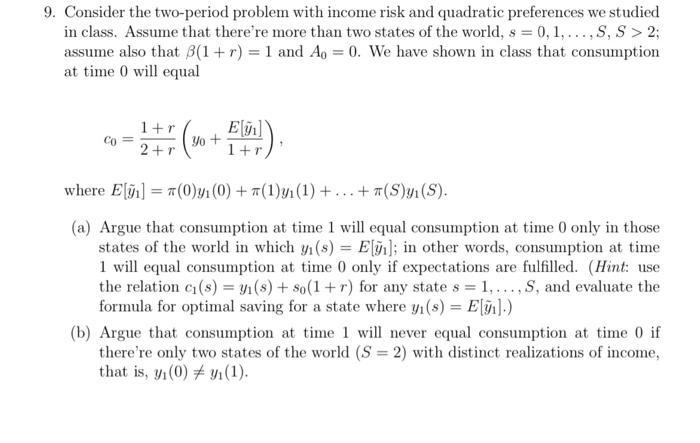Answered step by step
Verified Expert Solution
Question
1 Approved Answer
9. Consider the two-period problem with income risk and quadratic preferences we studied in class. Assume that there're more than two states of the

9. Consider the two-period problem with income risk and quadratic preferences we studied in class. Assume that there're more than two states of the world, s = 0, 1,...,S, S > 2; assume also that 3(1+r) = 1 and Ao = 0. We have shown in class that consumption at time 0 will equal 1+r 2+r Yo + E[] 1+r) where E[] = 7(0)y (0)+7(1)y (1) +...+(S)y (S). (a) Argue that consumption at time 1 will equal consumption at time 0 only in those states of the world in which y (s) = E[]); in other words, consumption at time 1 will equal consumption at time 0 only if expectations are fulfilled. (Hint: use the relation c (s) = y(s) + so(1+r) for any state s = 1,..., S, and evaluate the formula for optimal saving for a state where y(s) = E[].) (b) Argue that consumption at time 1 will never equal consumption at time 0 if there're only two states of the world (S = 2) with distinct realizations of income, that is, y (0) (1).
Step by Step Solution
★★★★★
3.42 Rating (161 Votes )
There are 3 Steps involved in it
Step: 1
Lets take a look at the two parts of the question youve provided a Argue that consumption at time 1 will equal consumption at time 0 only in those sta...
Get Instant Access to Expert-Tailored Solutions
See step-by-step solutions with expert insights and AI powered tools for academic success
Step: 2

Step: 3

Ace Your Homework with AI
Get the answers you need in no time with our AI-driven, step-by-step assistance
Get Started


